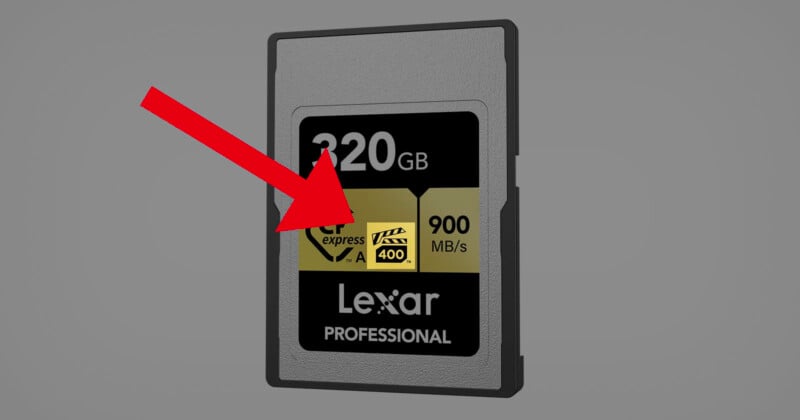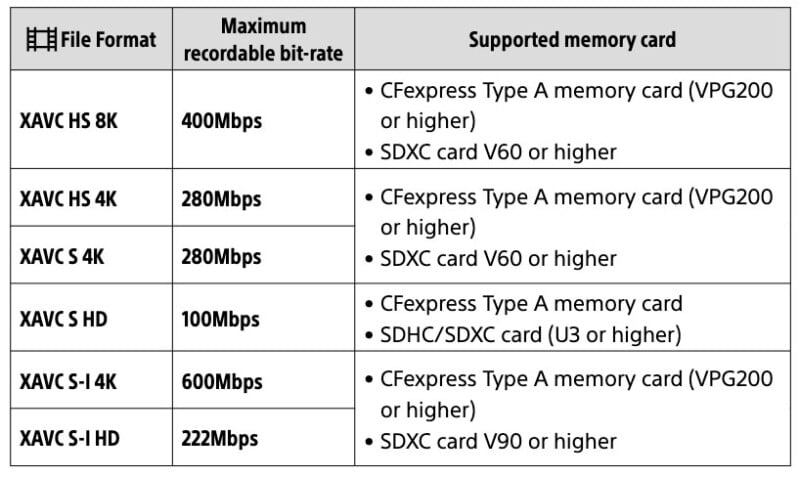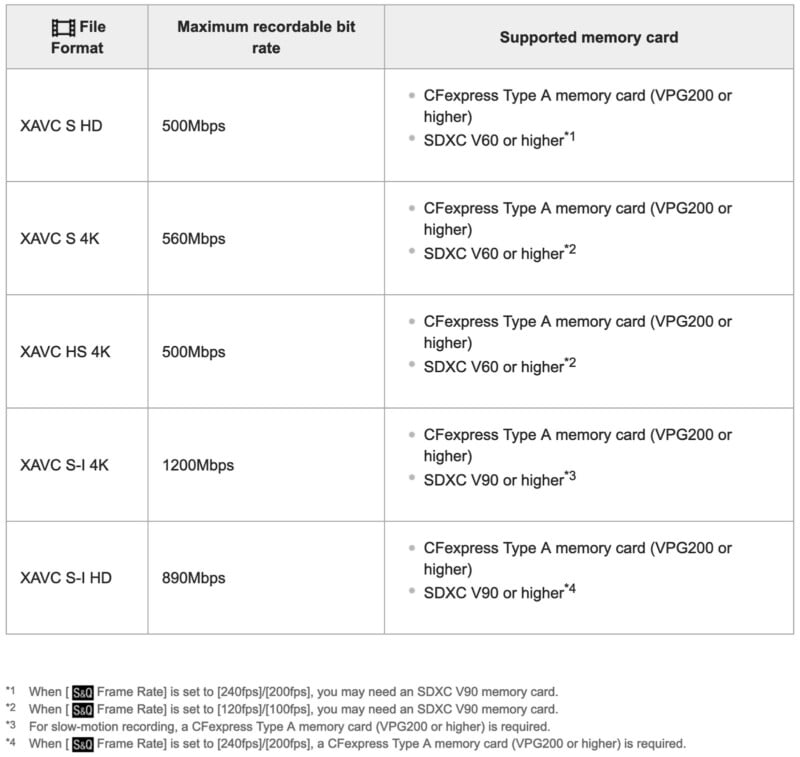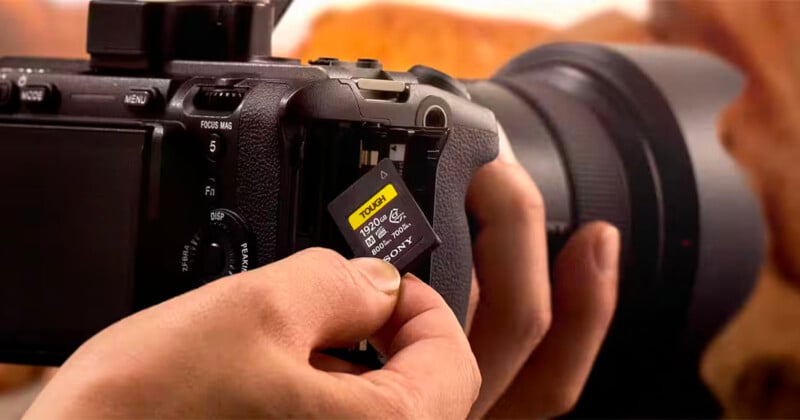Sony Photographers Need to Be Careful What Memory Cards They Buy
![]()
Photographers who use any of Sony’s most recent cameras are no doubt familiar with CFexpress Type A cards. As Sony is the only manufacturer to use the format, the cards are usually expensive. There are some cheap options out there, but unfortunately, they still come with a cost.
When compared to other electronics, there is a somewhat unusual burden that gets placed on photographers that forces them to not only read the fine print of the memory cards they buy, but also understand a breadth of symbols that, to a newcomer, may as well be ancient hieroglyphics.
For the most part, photographers have been able to lean on two main numbers, though: the read and write speed in MB/s. For cameras that promised full functionality with SD cards, as long as those numbers were above 90 MB/s, they were good. Now, obviously that’s an oversimplification, but let’s be honest about the situation. It’s actually insane that PetaPixel‘s guide to memory cards needed to use nearly 3,000 words to explain what bus speed, speed, class, UHS speed class, and video speed class actually mean, not to mention that there are probably many photographers that still don’t know the difference between CFexpress Type A and Type B.
Memory card companies and the organizations that manage them have not historically really done the best job of making this easy to understand and combined with the fact that there are so many users who just don’t know (or care) what all of it means, it should come as no surprise that, with millions of dollars being spent on memory a year, the market is filled with some less than forthright players.
While there are questionable makers across the various types of cards, the most important one to focus on right now is CFexpress Type A.
The Important Facts First
The easiest way to explain this situation is to first state a series of facts. First, CFexpress Type A is a format that any camera maker can use, but only one camera maker currently does: Sony.
Second, the Compact Flash Association — which owns the trademarks, intellectual property, and logos associated with CFexpress — is a non-profit organization made up of more than 80 members across the host, card, peripheral, and tester manufacturers. It has rules in place to assure quality and performance as well as compliance with its specifications.
One of those specifications is called Video Performance Guarantee, or VPG. This metric promises that a card will never dip below a certain MB/s speed and is granted at various levels: 20, 65, 130, 200, and 400. A VPG 400 card, for example, is guaranteed to never have its write speed drop below 400 MB/s, so cameras that have particularly high data rates will require this score to assure a filmmaker that if used, it will not drop a single frame during a recording session.

Of note, while the CFA could score a card at 20, 65, and 130, it doesn’t. The only cards that are VPG certified on the market are at least 200 and the majority score at 400.
Third, Sony points out in its user manual for cameras that shoot at either high resolution or high framerate (or both) that it requires a CFexpress Type A card to score at least VPG200. The Alpha 1, for example, is one such camera to require this.

Of note, it only requires an SD card to rate V60 (meaning it has to sustain at least 60 MB/s, although some features are better if a card is a V90, or 90 MB/s). This speed incongruity is likely tied to the fact that the CFA doesn’t actually score VPG below 200 in practice, and Sony opted to go with the lowest possible requirement here. This is just speculation, but we have no other explanation for the vast difference in speed requirements. Whatever the reason may be, Sony cameras will check a CFexpress card for a specific firmware flag that confirms it has the VPG200 certification in order to allow access to the highest video recording levels. If that flag isn’t detected, the camera will “gray out” the selection in the menu.
The Sony a7s III “Help Guide” also outlines VPG requirements for specific S&Q video modes.

So with that said, we know that if a CFexpress Type A card exists, it’s being made to work with Sony cameras and Sony cameras are looking for specific performance guarantees in order to function fully.
Cards Are Cheating the System
One more fact that photographers know all too well is that CFexpress cards are very expensive and CFexpress Type A cards are especially so. As a result, people are going to be shopping for the best possible deal to get the most bang for their buck. Because of this, some companies stand out by making cards that are far cheaper than the competition. How are they doing it? The average photographer probably doesn’t care. The only thing that matters is that they can get more cards for less money.
That is, unfortunately, not necessarily the right move. While we do like to advocate to pick up gear on sale, there is some chicanery going on in the memory card world where companies are not going through the process to get a VPG rating but falsely including a certification firmware flag so that Sony cameras think they did.
This practice takes advantage of a few factors. One, memory cards are confusing and the symbols don’t mean much to the average person. Two, memory cards are expensive, and being cheap is a good way to move products. Three, the CFA has been relatively quiet and downright secretive about how it operates and therefore it doesn’t speak out publicly to address issues with its licensees, instead choosing to try and fix these issues behind closed doors.
What this means is that some of the best selling, top results for CFexpress Type A memory cards on Amazon are not abiding by the CFA’s rules, are not actually getting their performance checked, and are straight up lying to your camera by pretending they did.
Does this mean the cards won’t work right? Not necessarily, but it also means no one actually checked.
The testing required to obtain a VPG rating is extremely rigorous. Tests are performed on multiple cards and take days to complete, which makes sense: if the word “guarantee” is in the name, then the CFA wants to stand by the definition of the word. But this process costs money and manufacturers who would rather try and earn market share by undercutting the competition don’t necessarily want to incur more costs that would prevent that. So they don’t, and by faking the firmware, cameras are none the wiser.
How to Recognize a Cheat
It’s really easy to know if a company is cheating the system. If you purchased a CFexpress Type A memory card for your Sony camera and it doesn’t have the VPG logo on it but your ability to record in all the frame rate and resolution options isn’t grayed out in your menu, the card has been programmed to lie. That means while it might work, that performance has not been proven to and the company you bought from didn’t play by the rules to which everyone else is being held.

The entire point of the VPG logo is to give consumers some level of confidence that what they’re buying will actually work as advertised. Other memory card formats work on an honor system: a company tests internally and says it will perform a certain way and that’s the end of the story. The CFA wanted to actually hold companies to a real standard and that means consumers should have more confidence in a product.
Unfortunately, this isn’t really communicated well to the buyer and as a result, some companies have been able to treat the space like the wild west.
The goal here is to help maintain that standard, so going forward PetaPixel will only recommend CFexpress Type A cards that are properly labeled and are confirmed to have passed the VPG certification.
That means as of today, Sony shooters should go with ProGrade Digital, Sony Tough, Delkin, and Lexar in order to get maximum performance out of a high-end Sony camera that has been verified. There are options from a few others now, but these four have been upfront and honest for the entire time they’ve made CFexpress Type A cards while there are others who are doing the right thing now, previous cards they made weren’t and are still on the market.
Really cheap options, like Pergear’s, or any CFexpress Type A card that doesn’t have a VPG logo on the label should be avoided or at least approached with caution and skepticism.
Editorial note: This information only recently came to light for us after some conversation with industry experts. As mentioned, much of this is shrouded in secrecy so it has been difficult to give you straight answers. That’s why PetaPixel has shared news and information about cards that apparently violated the CFA’s rules in the past and why those brands haven’t been featured lately, even if you’ve seen them on other websites. We don’t delete stories here on PetaPixel because we treat our site as an archive, but expect what we now know to play a role in our editorial coverage moving forward.